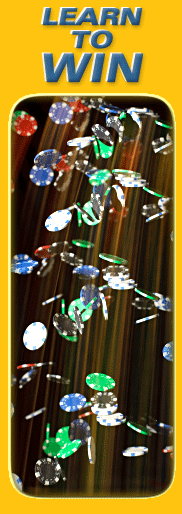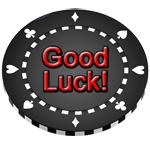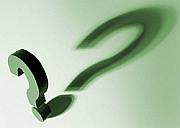Blackjack Basics: Playing for the First Time
by Henry Tamburin
Blackjack Basics, a lesson at Learn to Play Blackjack Program is for new players, but first let’s face some facts.
FACT: Blackjack is your best bet in a casino.
FACT: The majority of casino players play the slots.
Do you see something wrong here? I do, which is why I asked several of my die-hard, slot- playing friends why they don't play blackjack.
In a nutshell, their response went something like this:
"I'm afraid of making a playing mistake that will screw up the blackjack table and cause players to lose".
OK, being intimidating is a fair reason for not playing. But how does a wannabe player overcome this fear?
According to a psychologist friend-of-mine to overcome someone's fear of doing something you've got to "build up their confidence in whatever they are afraid of doing".
Webster's dictionary defines confidence as "a faith or belief that one will act in a right, proper, or effective way".
My task with this Blackjack Basics lesson is to build the confidence of all you slots-only players to play this game by explaining to you the right and effective way to play.
I'm game if you are so let's give it a try.
Blackjack Basics 1
First, you've got to understand the playing rules.
The game is played with one or more decks of cards.
Whether a casino uses one or 8 decks is for the moment of no consequence so don't worry about it.
In blackjack, every card in the 52-card deck counts its face value and you can ignore the suits.
Picture cards have a value of 10 and the ace has a value of 11 or 1 (your choice). A blackjack, which is the highest hand, consists of an ace plus any ten value card (10, jack, queen, or king).
Blackjacks are special because players win an extra payoff (1.5 times their initial bet).
Blackjack Basics 2
Next up is to understand the objective of the game.
You might think this is trivial but you'd be surprised at how many players believe the objective is to get to as close to 21 as possible. Wrong.
The objective is to add up the values of all the cards in your hand and hope that your hand totals higher than the dealer or you can win if your hand totals 21 or less when the dealer busts.
The latter is a term that means a dealer or player's hand has exceeded 21.
Here are some examples of how you win or lose your hand.
If your hand totals 19 and the dealer's hand is 17 you win, (you get paid 1 to 1). If you have a 16 (or any total under 21) and the dealer busts you win.
If you have 19 and the dealer has 20, you lose. By the way, if you and the dealer have the same total that's a push or tie and you don't win or lose. So if you have an 18 and the dealer has an 18, it's a push and you don't lose your initial bet.
Blackjack Basics 3
Play begins after players make their bets in the betting area in front of them. If you don't have any casino chips to bet with, just place your money on the layout after a round is over and ask the dealer for chips. The dealer will count your cash and exchange them for casino chips.
After all bets are made, the dealer will deal two cards to each player and one card face up and one face down to himself.
Sometimes the dealer will deal the player cards face up and other times face down or one up and one down.
Not to worry because it really doesn't make a difference which way he does it. However, as a general rule, when multiple decks of cards are dealt from a device known as a dealing shoe, the player cards are dealt face up. In single deck games, player's cards are usually 'pitched' by the dealer face down.
Blackjack Basics 4
Always remember that when you play, it's you against the dealer. Don't worry about what cards your fellow players get because that is not what's important. Just focus on your hand and the value of the dealer's upcard.
Blackjack Basics 5
Players have certain playing options available to them to try to improve their hand. By using these options correctly, you can significantly reduce the casino's edge.
Let's start with hitting and standing and we'll assume a typical 6-deck game dealt from a shoe.
Taking a hit means you want the dealer to give you another card. You would normally take a hit when the value of your hand is low. The risk when you hit is that if you bust you automatically lose.
You must signal the dealer that you want another card by making a beckoning motion with your finger or scratching it on the felt (this is done for security reasons).
When you ask for another card the dealer will give it to you face up. You can ask for as many cards as you want but remember the automatic loss rule if you bust.
If you are satisfied with the total of your hand, you should stand. Signal this to the dealer by waving your hand over the cards.
Blackjack Basics 6
You can double your initial wager by one of two ways. The first is known as doubling down and the second is pair splitting. These are very important playing plays so pay attention.
When you want to double down, you match your original bet by placing the equivalent amount of chips next to (not on top) of your original bet.
The dealer will give you one and only one more card. Strategically, it's wise to double down when your initial two-card hand totals 11 or 10. You are hoping of course to draw a 10 or picture card for a 20 or 21. Sometime it works and sometimes it doesn't but in the long run, you'll win more money by doubling down on these hands compared to hitting (we'll cover the strategy on when to double down in a moment).
If you have a pair (or two like cards), players have the option of splitting them and playing out two hands.
Suppose you bet $5 and are dealt a pair of 8's for a 16. You are much better off splitting the 8's and playing two hands starting with 8 then playing the initial hand as a 16.
To initiate the pair splitting you would double your bet just like you do when you double down (place the secondary bet next to the initial bet).
Blackjack Basics 7
Finally, there is this option known as insurance. It's a bad bet for players so I won't even waste anytime explaining the bet.
Just do nothing when the dealer asks players if they want to make the insurance bet.
It’s also a confidence builder if you attend the free lessons offered by the casino. Don’t expect them to teach you the best way to play your hands. But you’ll get the chance to sit at a table and observe the mechanics of the game under the watchful eye of a dealer instructor.
Once you get the hang of how the game is played, you need to learn the basic playing strategy. You can take a basic strategy card with you when you play (they are casino legal).
So what are you waiting for? Blackjack is fun and it’s the best gamble in the casino.
Blackjack Basics is followed by Reasons to consider Blackjack
OR
Return to Learn to Play Blackjack Program
GT is attentive about getting the word out about our free programs, lessons and add-ons offered, however, we ask your assistance and consideration in promoting us.
Click link below that reads, "Enjoy this page? Please pay it forward. Here's how..." to add a link to your site, blog or personal page.
Tips, Terms & Wins
Blackjack Side Bets:5 Card 21
This side bet pays 2 to 1 if the player gets a winning 5-card hand totaling 21.
There are about 20 deviations from basic strategy for any player who wants to try for the 5 card 21 and the house edge is only 0.2%.





